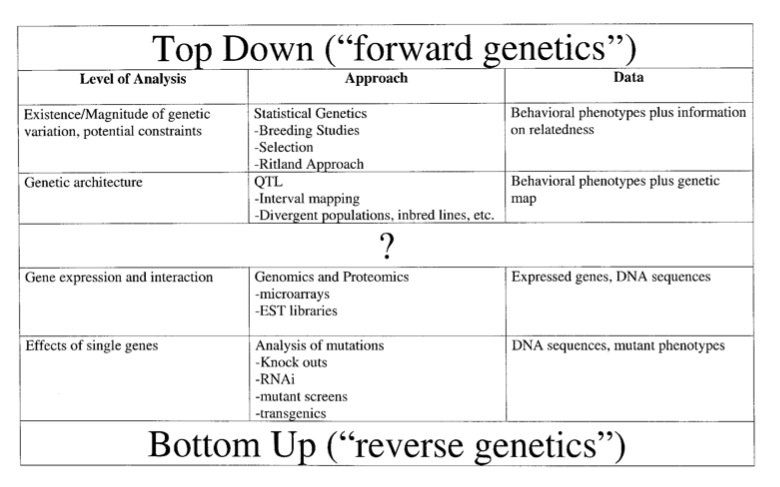 Animal Behavior
Animal Behavior
Biology 342 Fall 2010
Week 4
Sept. 20th & 22nd
Behavioral Genetics
When we search for the proximate factors for behavioral causes, we naturally
start with genes. Our understanding of how genes influence behavior has
been advanced both by studies of wild populations and model organisms
in the lab. While early studies identified single genes of large effect
we now know that the genomic architecture of many behaviors is complex. These
are two separate, but complementary approaches.
While much of our understanding of behavioral genetics derives from Drosophila mutants
and white lab mice, the examples of natural behavioral phenotypes affected
by naturally occurring allelic variation are potentailly more exciting
because these represent adaptive phenotypes (we'll get to a discussion
of adaptation later). This excitement for adaptive behaviors comes at
a cost; one must weigh the relative benefits and choose experimental
systems wisely.
Required READING:
As a simple introduction to the type of behaivoral genetic studies that have been done in Drosophila...
Vosshall L. 2007 The mind of a fly Nature 450:193-197.
For a fantastic and historic example of an artificial selection experiment read ...
Trutt 1999 Early Canid
Domestication: The Farm-Fox Experiment. American Scientist 87:159-169.
Though, I expect it will be somewhat challenging, I ask you to read the following review.
Boak, C.R.B., Arnold,
S.J., Breden, F., Meffert, L.M., Ritchie, M.G., Taylor,B.J., Wolf, J.B.,
Moore, A.J. (2002) Genetic Tools for Studying Adaptation
and the evolution of behavior. The American Naturalist 160:S143-159.
Consider the large "?" in this figure.
Can you find recent research that allows us to bridge this gap?
Keep this in mind throughout the semester as we read more research papers and see additional examples in the text book.

ADDITIONAL READING (not required)
As a Neuroethology conference in Salamaca Spain during the summer of 2010 I heard a talk by Neil J. Vickers regarding his work to identify the genetic basis of species-specific olfactory behavior in two closely related moth species that was also recently published (Gould et al 2010). In my mind this is one excellent example of a study that bridges the gap. There is a recent short review of that work which may help to emphasize the important points (Heckel 2010).
ADDITIONAL READING (not required)
Additional (more complicated studies concernning behavioral genetics)
Sokolowski (2001) Drosophila:
Behavior meets Genetics. Nature Genetics 2:877-892.
To find human genes known to strongly influence behavior check out the
NIH website Online
Mendelian Inheritance of Man and look up behavior.
For a controversial study read the following paper and do some digging to find the commentary that ensued.
--Strains of mice that show characteristic patterns of behavior are critical
for research in neurobehavioral genetics. Crabbe (from OHSU) and colleagues
performed replicated behavioral tests in several labs across the country
to validate these assumptions (Wahlsten_2003).
MacKay, T.F.C. and
Anholt, R.R.H (2008) Ain't misbehavin'? Genotype-environment
interactions and the genetics of behavior. Trends in Genetics 23:311-314.